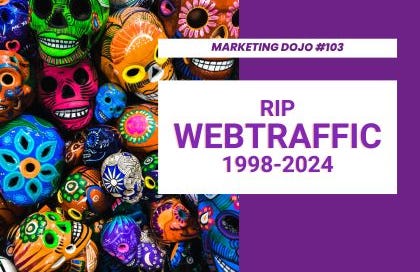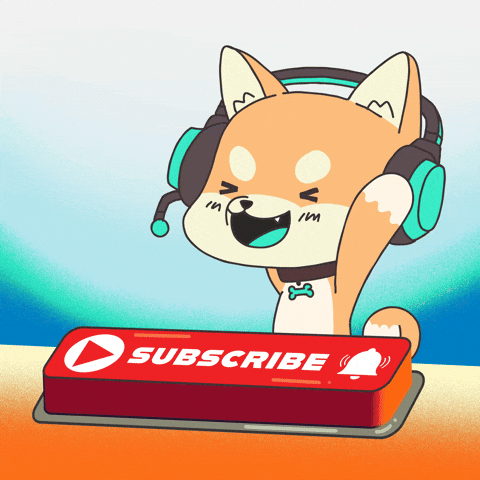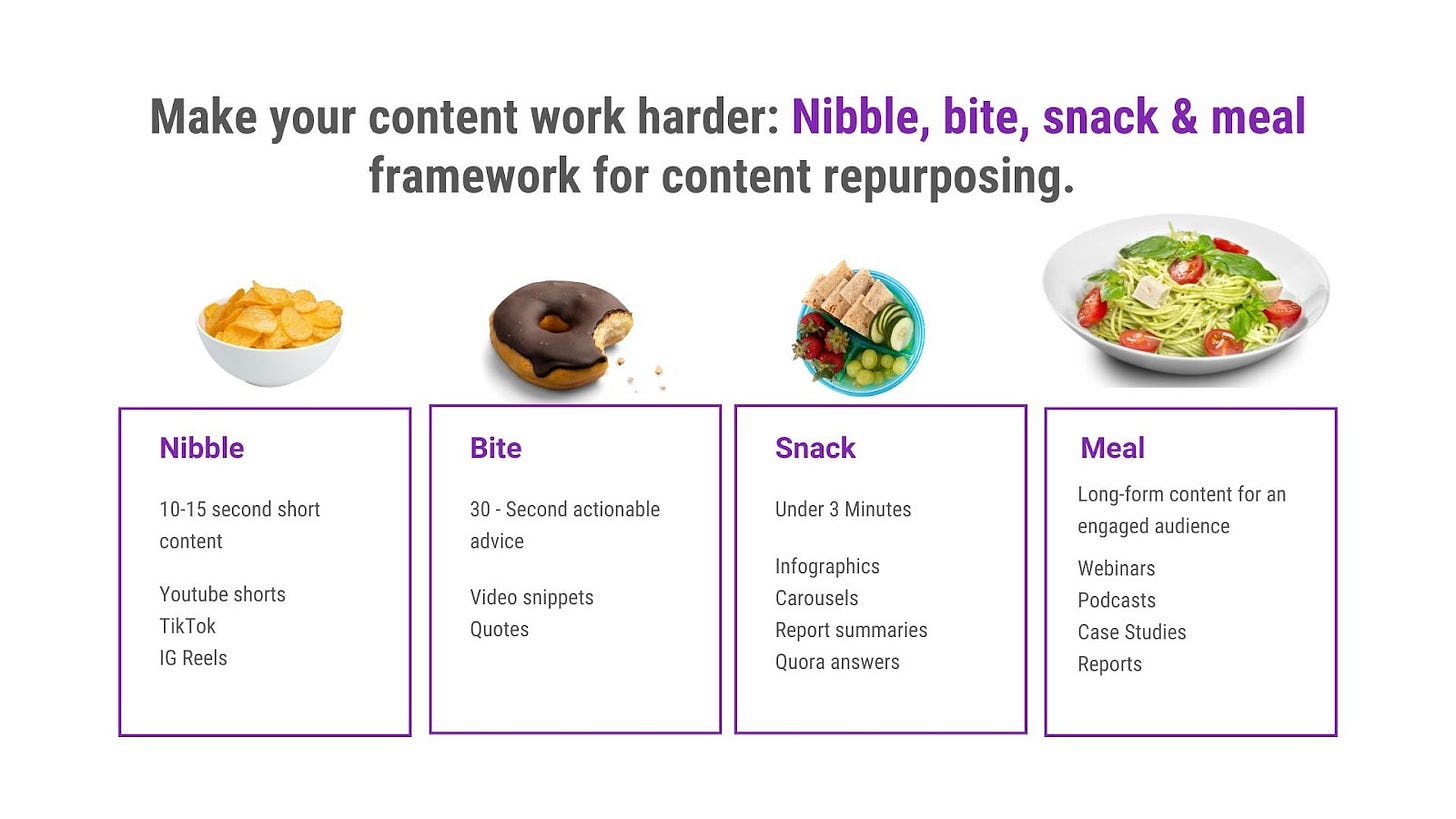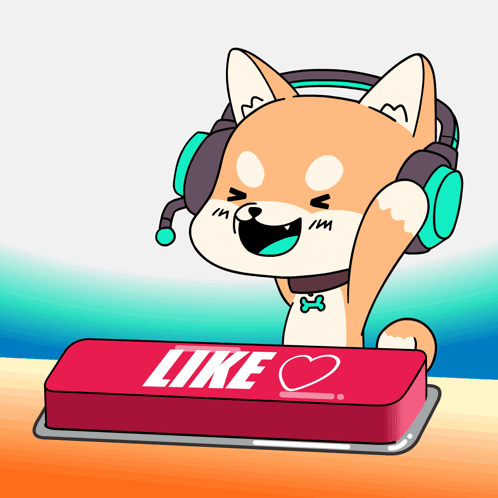MarketingDojo #103: 💀RIP Web Traffic: 1998-2024🪦
B2B Click Through Rates are down 30%, Eggs-traordinary marketing stunt by The Ordinary, Content IP and more.
Here's how you can turn your family photos into Ghibli-style portraits.
I'm just kidding.
I'm never going to do that. And I'm not jumping on this bandwagon.
Trust me; I'm not claiming any moral high ground. Those pictures are cute and magically make everyone look thinner.
But I have mixed feelings about this trend—more on my rant in the P.S. section.
Good marketing runs deeper than fleeting trends (thank goodness). Here's what we're covering today:
📉 B2B Web Traffic Declines
🎭 Creative excellence: Eggs-traordinary Marketing Stunt
🤖 Consumer trust and AI images
🧠 Creating a ContentIP
Oh, before we dive in, can this cutie convince you to subscribe if you haven’t yet?
No Clicks, No Cries: Surviving Google's Traffic Apocalypse
I am afraid to check our website analytics these days. Google's AI overviews are the reason why.
Fresh data from Bain & Company confirms what many B2B marketers have quietly feared: website click-through rates for B2B software queries plunged 30% between January 2024 and January 2025.
Today, Google AI overviews appear in nearly 47% of all search queries, providing answers right there—no clicks, no visits, no leads.
Last summer, I tackled this emerging crisis in my article, "Who Moved My Traffic?" Things have evolved quickly since then, and although the original advice still holds water, some updates are needed. For now, here's what still works:
Repurpose everything.
Have a 25-minute webinar? Chop it into snackable YouTube Shorts, engaging LinkedIn posts, or punchy email snippets. Maximize every bit of your content.Stop depending solely on Google.
Putting all your eggs in Google's basket is like trusting your goldfish with a hungry cat. Diversify your channels—explore underrated opportunities on YouTube or leverage your employees as LinkedIn advocates.Embrace the window shoppers.
Not every website visitor is ready for your sales pitch. Some just browse, like the friend who tries on everything but buys nothing. Focus on nurturing marketable contacts instead of chasing every form fill.Avoid copycat content.
Google's AI thrives on generic industry content. Stand out by providing unique, niche insights your audience truly values.Collaborate, don't compete.
As the traffic pie shrinks, partnerships matter more than ever. Team up with complementary brands to co-market, co-brand, and navigate this AI-driven landscape together.
With Generative Engine Optimization rising fast, this list is due for an update—soon, I promise!
Have you noticed changes in your website traffic? What's working (or not) for you? Hit reply and share your story—I'd love to hear from you.
Creative Excellence: The Eggs-traordinary Move By The Ordinary.
Why on earth is a skincare brand selling eggs?
The minimalist skincare brand The Ordinary recently pulled off an incredible, perfectly timed marketing stunt that's winning applause across social media.
Quick backstory: With avian influenza ravaging the US, egg prices soared to nearly $8.75 per dozen in March. Spotting an opportunity, The Ordinary cleverly stepped into grocery aisles—not skincare shelves—and started selling eggs for just $3.37 per dozen.
Social media ate it up. But beyond the virality, three reasons why this stunt is pure marketing genius:
True to Their Roots: The Ordinary built its brand on making skincare affordable and accessible. By applying the same principle to eggs, they've brilliantly reinforced their core value—affordability.
Distinctive Visual Identity: Notice how minimalist and striking The Ordinary's product packaging is? They used that same clean, unmistakably bare white aesthetic for their egg cartons, making them instantly recognizable.
Hitting the Right Insight: Great marketing taps into real consumer pain points. The Ordinary addressed a genuine, timely frustration—skyrocketing grocery bills.
While most praised the creativity and perfect timing, some questioned the contradiction of a vegan brand selling eggs.
Skincare and eggs? Turns out it was a match made in marketing heaven.
Label That Pain: Why Naming Problems Sells Solutions
Remember when you felt off during the pandemic—not sad, not depressed, just... meh?
Then, Adam Grant came along and said: "You're languishing."
Boom. We finally had a name for that weird in-between state—and the internet exploded.
The same thing happened with quiet quitting. The Great Resignation. Revenge bedtime procrastination. And most recently- vibe coding.
Once the problem gets a name, it spreads like wildfire. Because naming makes the invisible, visible. And suddenly, it's everywhere.
That's the power of language.
In the Growth Sprints newsletter, Brendan Hufford introduced the concept of ContentIP - a hack to make B2B marketing memorable.
Content IP = Naming the problem your product solves.
Instead of describing pain points in generic terms, you give them a name.
And when that name clicks, your audience has that "snap and point" moment:
"Yes! That's exactly what I've been struggling with!"
Some brands are already crushing this:
Growth Sprints → "Checkbox Marketing"
Operator.ai → "The Great Ignore"
Copy.ai → "GTM Bloat"
The beauty of this approach? Once you've named a problem effectively, even your competitors end up using your terminology. You've reframed the entire conversation on your terms.
Here's Brendan's 3-step playbook:
Find the pain point
Talk to your customers. What frustrates them? What's eating into their time, energy, or revenue?
Give it a name
Make it short, sticky, and catchy. Two to three words max. Bonus points for alliteration.
Repeat it
Say it in emails. LinkedIn posts. Sales calls. Your team meetings. If you're tired of saying it, you're probably doing it right.
As marketers, we're always hunting for sticky ideas. This one's a keeper.
The Trust Tax on AI-Generated Images
Should we jump on the AI-generated image bandwagon?
That's the real debate happening on most marketing teams right now.
AI-generated images are cheaper, faster, and endlessly customizable. The models are getting better at light speed - blink, and they've leveled up again.
Yet this convenience might come at the cost of something more valuable -
𝐂𝐨𝐧𝐬𝐮𝐦𝐞𝐫 𝐭𝐫𝐮𝐬𝐭.
According to Accenture's Life Trends 2025, half of all consumers say it matters if their bank or healthcare provider uses AI-generated images.
Getty Images surveyed 30,000 people across 25 countries:
• 98% say authentic visuals build trust
• 90% want transparency about AI images
So yes — AI images are practical. But trust is powerful. And fragile.
How are you and your team navigating this? Are you using AI images? If so, how are you maintaining transparency?
Short Stuff:
Facebook to introduce Friends tab to get back to the OG FB vibe (Why does it sound like a good idea!!).
Amazon launches "Interests," a generative AI tool that allows customers to input personalized prompts for unique shopping experience. (AI for hyperpersonalization).
Venmo co-founder launched a new social media platform called Jelly Jelly (It comes with a Solana-backed Memecoin called Jelly-My-Jelly. So unserious!).
That’s a wrap on this week. Thank you for your time and attention. If you made it this far and enjoyed what you read, remember to leave a like. It will make and this little kitten very happy.
I will see you in your inbox next Wednesday.
Regards,
P.S:
“ An insult to life itself “ - Hayao Miyazaki, Co-founder Studio Ghibli on Artificial Intelligence.
Thanks to ChatGPT’s latest update, my LinkedIn feed is full of folks turning their pictures into Studio Ghibli style. It is cute.
But how does the artist who has spent his entire life perfecting every smile, every grin, every grimace in the Ghibli universe feel about the technology?
In 2016, Hayayo Miyazaki shared his strong views in unequivocal terms.
My Neighbour Totoro was my first introduction to Studio Ghibli's work. It remains one of my favorite movies. It left me feeling that we can find joy, hope and connection no matter the circumstances. In deference to the artist's wishes, I hope this trend vanishes just as quickly as it appeared.
The last line of the video is part emotional outburst and part foreshadowing - “I feel like we are nearing the end of times.”
Are we?










